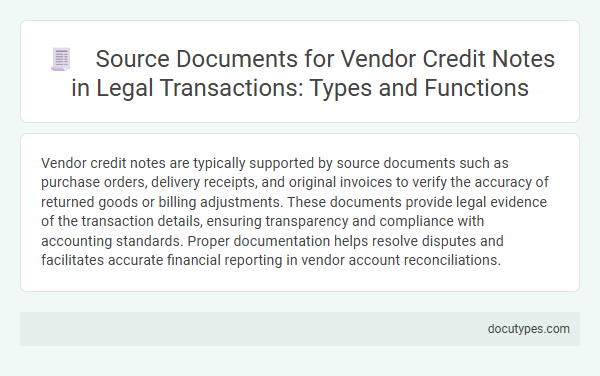Vendor credit notes are typically supported by source documents such as purchase orders, delivery receipts, and original invoices to verify the accuracy of returned goods or billing adjustments. These documents provide legal evidence of the transaction details, ensuring transparency and compliance with accounting standards. Proper documentation helps resolve disputes and facilitates accurate financial reporting in vendor account reconciliations.
Introduction to Vendor Credit Notes in Legal Transactions
Vendor credit notes serve as official documents issued by suppliers to buyers, indicating a reduction in the amount owed due to returns, errors, or agreed discounts. These documents play a crucial role in legal transactions by providing proof of adjustments to invoices and ensuring accurate financial records. Common source documents used to support vendor credit notes include purchase orders, delivery receipts, and original invoices.
Definition and Importance of Source Documents
| Aspect | Details |
|---|---|
| Definition of Source Documents | Source documents are original records that serve as evidence for financial transactions involving vendor credit notes. These documents provide detailed information about the transaction, such as date, amount, parties involved, and reason for the credit. |
| Importance of Source Documents | Source documents ensure accuracy and transparency in financial reporting. They support audit trails, validate credit claims, prevent fraud, and guarantee compliance with accounting standards and legal requirements related to vendor credit notes. |
| Common Types of Source Documents for Vendor Credit Notes |
|
| Role in Financial Controls | Maintaining source documents for vendor credit notes is critical for internal control. It enables verification of credits applied, helps reconcile accounts payable, and assists in resolving disputes with vendors. |
Key Legal Requirements for Vendor Credit Note Documentation
Vendor credit notes require precise source documents to ensure legal compliance and accurate financial reporting. Your attention to these key legal requirements helps maintain transparency and reduces disputes.
- Purchase Orders - These documents verify the original agreement between buyer and vendor, essential for validating credit note claims.
- Delivery Receipts - They provide proof of goods received or returned, supporting the legitimacy of the credit note.
- Invoices - Original invoices linked to the credit note must be retained to demonstrate the financial context of the transaction.
Proper documentation safeguards your business against fraud and ensures compliance with auditing standards.
Types of Source Documents in Vendor Credit Notes
Vendor credit notes require specific types of source documents to validate the transaction accurately. Common source documents include purchase orders, delivery receipts, and original invoices.
These documents help verify the return of goods or correction of billing errors. You should ensure these records are accurate to maintain proper accounting and vendor relations.
Supplier Invoices as Source Documents
Supplier invoices are the primary source documents used for vendor credit notes, providing detailed records of goods or services received and their corresponding costs. These invoices serve as proof for adjustments or returns, ensuring that your accounting remains accurate and transparent. Maintaining accurate supplier invoices helps streamline the credit note process and supports effective vendor relationship management.
Purchase Orders and Their Legal Role
Purchase orders serve as primary source documents for vendor credit notes by detailing the original terms of the transaction. Their legal role is crucial in verifying the legitimacy and accuracy of credit claims between parties.
- Purchase Orders - These documents outline the agreed-upon goods or services and prices, establishing a contractual basis for credit notes.
- Contractual Evidence - Purchase orders act as binding agreements that support your right to request vendor credit adjustments.
- Dispute Resolution - Accurate purchase orders help resolve discrepancies by providing clear proof of the original transaction terms.
Delivery Receipts and Acknowledgments
Source documents for vendor credit notes often include delivery receipts and acknowledgments. These documents serve as proof of returned goods or discrepancies in delivered items.
Delivery receipts detail the products received and verify the quantity and condition at the time of delivery. Acknowledgments from vendors confirm acceptance of returned items or agreement on credit adjustments. Both documents are essential to validate and process vendor credit notes accurately.
Contractual Agreements Supporting Credit Notes
Contractual agreements play a crucial role in supporting vendor credit notes by providing legally binding terms and conditions. These documents establish the foundation for credit issuance, ensuring clarity and enforceability between vendors and buyers.
- Purchase Contracts - Detailed contracts outlining terms of sale, payment, and conditions for credits between buyer and vendor.
- Service Agreements - Contracts specifying service delivery milestones and provisions for adjustments or credits upon non-compliance.
- Amendment Letters - Written modifications to original contracts that authorize specific credit notes based on agreed changes.
Audit Trails and Recordkeeping Compliance
What types of source documents are used for vendor credit notes to ensure audit trails and recordkeeping compliance? Source documents typically include vendor credit memos, original purchase orders, and delivery receipts, which provide verifiable evidence of the transaction. These documents support accurate recordkeeping and facilitate thorough audit trails to meet regulatory requirements.
What Types of Source Documents Are Used for Vendor Credit Notes? Infographic

